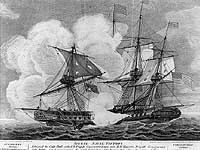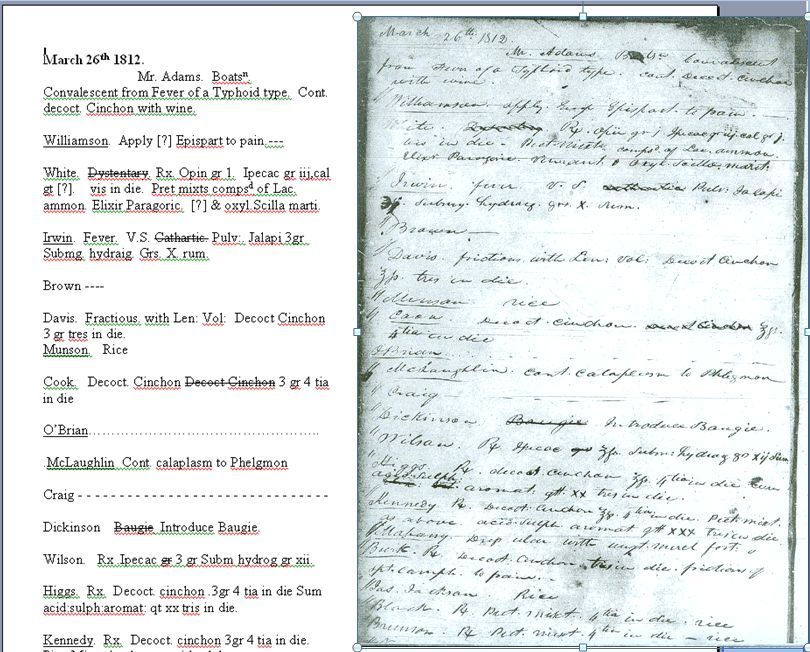what's new
 |
Action between USS Constitution and HMS Guerriere, 19 August 1812. Engraving "Designed, Engraved & Published by W. Strickland & W. Kneass", Philadelphia, Pennsylvania, 21 September 1812. U.S. Naval Historical Center Photograph #: NH 42914. |
Naval medicine in the War of 1812: 780 case histories
The bicentennial of the War of 1812 is fast approaching, and the USS Constitution Museum is preparing for it with new exhibits, online instructional games, and research into the lives of those who served aboard USS Constitution during the war.
The medical history of the crew aboard USS Constitution in 1812 and 1813 is well documented in the prescription book and journals of the ship's surgeon, Amos Evans. Evans's prescription book records the names of persons under medical care as well as their condition and treatment, generally for each day that they were under care.
Microfilm images of the prescription book are available in the Museum's research library. An electronic transcript of the book was made by historian Tyrone Martin for use in research. The transcript -- vastly more readable and searchable than the microfilm images -- had an additional advantage: it could easily be turned into a research database. I recently concluded the first part of this project by moving the entries into Access, splitting the data into assigned fields, and designing a report to present the patient entries by name and case in static HTML pages.
Strength of the data
The 7023 entries in the prescription book are a rich source of information for many reasons. The illnesses and wounds of roughly 780 medical cases in wartime are recorded. The entries (daily prescriptions and observations) were created in the moment, usually in the morning. Consequently, they reflect the thinking and observations of the writer at the time of entry and show almost no editing or alteration after the fact. The entries were detailed enough to serve as a reliable aid to the surgeon's memory and to the assistants and subordinates charged with actually treating the patients. The observations and treatments recorded each day are highly illustrative of the writer's understanding of medicine in the years 1812-1813. The entries also show the intersection of medical and naval judgment as the surgeon decided to return patients to duty or send them to the hospital.
 |
Daily Prescription Book on board U.S. Frigate Constitution, Isaac Hull Esq. commander Commencing March 26th 1812. |
Some caution was warranted in organizing this information. Date headings were occasionally inaccurate. Names were recorded with variant spellings. Modern day readings of nineteenth century expressions could lead to mischaracterization. (When the writer recorded that a patient "lost a little blood" was he describing his condition or treatment?) Without care, one might have organized the data with a twenty-first century understanding of health and disease, bringing to the project a knowledge of bacteria, viruses, vitamins, immune response, and genes, and thus misrepresent the information as recorded in 1812 and 1813.
In organizing and presenting this data, the current understanding of medicine -- experimental, evidence-based, statistically driven, often counter-intuitive, and disease-focused -- had to be set aside in favor of the nineteenth-century understanding of medicine -- traditional, anecdotal, humoral, intuitive, symptom-focused.
Breaking the data into fields was straightforward in most respects. Given the prescription book's format, all entries could have a date and patient name. Order of entry in the book was preserved by numbering the lines sequentially. The full entries as they appeared in the prescription book were preserved in one field. Parts of the full entries were copied into several other fields (condition, treatment, and disposition) for ease of analysis. A comment field was added for explanatory remarks about the case or interpretation of the language.
While the crew members of the USS Constitution are known for the period covered by the prescription book, it is not always clear which crew members are referred to in the book, particularly in the case of common names like Smith or names that were spelled in a variety of ways. It is almost always clear, however, which entries belong together as part of the same case. Consequently, entries reflecting ongoing treatment of the same person were assigned a unique case number, and a related record was created to hold information about the case, including a basic characterization of the condition being treated: illness (new or old), injury (new or old) or battle wound.
No attempt was made at this stage to describe the patients' illnesses beyond these obvious categories. While the doctors sometimes named illnesses that they were familiar with, such as scurvy or venereal disease, they more typically recorded symptoms only, often as reported by the patient. Some patient conditions such as loose bowels and sore gums were the expected result of the treatments applied (castor oil, ipecac, lead, mercury, bleeding, blistering, and friction, to name a few).
 |
First page of patient entries in prescription book, and transcription by Tyrone Martin |
In the case of injuries or battle wounds, the prescription book entries are less ambiguous. A cause for routine injuries is sometimes given in a patient's initial entry ("a Box of candles fell from the deck & struck his right cheek..."). Bruises, cuts, strained backs, and falls are among the more common injuries described. Battle wounds are described even more precisely than injuries, particularly when surgery was required. When a person's position on the ship is known, where and how he received his wounds can also suggest damage that occurred to the ship itself.
The prescription book data was collected and arranged in Access. The database generates reports in the form of static HTML pages with links between patient names and their daily entries in the book. These HTML pages give Museum staff and researchers practical access to the information they need to complete the crew member biographies. Queries and standing reports in Access allow for some analysis of the cases. I am currently designing dynamic pages that respond to user input and load more quickly. An edited version of the prescription book with XML coding to explain medical terms and give patient biographies would be ideal.
Next steps
The prescription book database is currently in use only within the USS Constitution Museum research library. I am identifying those entries that are not yet associated with other known cases in the prescription book and reviewing the coding of cases as illnesses, injuries, or battle wounds.
Some next steps include the following:
- Identifying the person in a particular case with his identity in the database of crew members maintained by the Museum.
- Coding the entries and cases for types of illness, types of injury, or symptom groups to the degree this is possible.
Future projects may include the following:
- Comparing the number of sick and injured in the prescription book with the number reported in ship’s log.
- Determining the incidence of illness or injury on any given day of a cruise.
- Determining the mean and median number of days that patients were under treatment.
- Coding the entries for symptoms described or types of treatment. Patient treatments are the most carefully detailed part of the record.
- Looking at patient biographies for long-term effects of known illnesses and treatments. Thanks to work already done by the staff at the USS Constitution Museum, much is known about the later lives of some sailors and marines who served on USS Constitution.
An abbreviated version of the prescription book database showing only a portion of the 780 cases is posted here for demonstration purposes. .